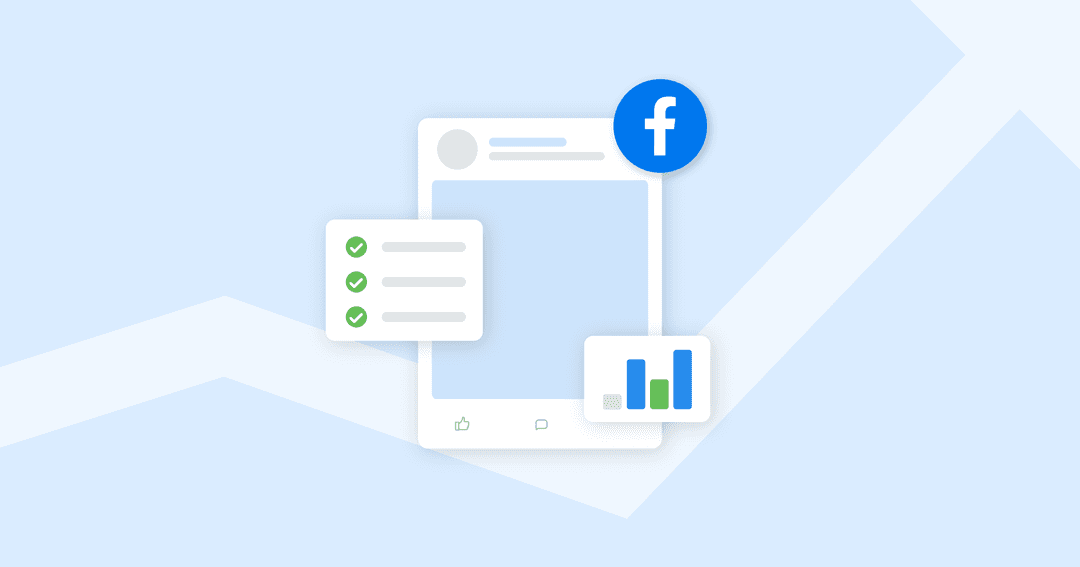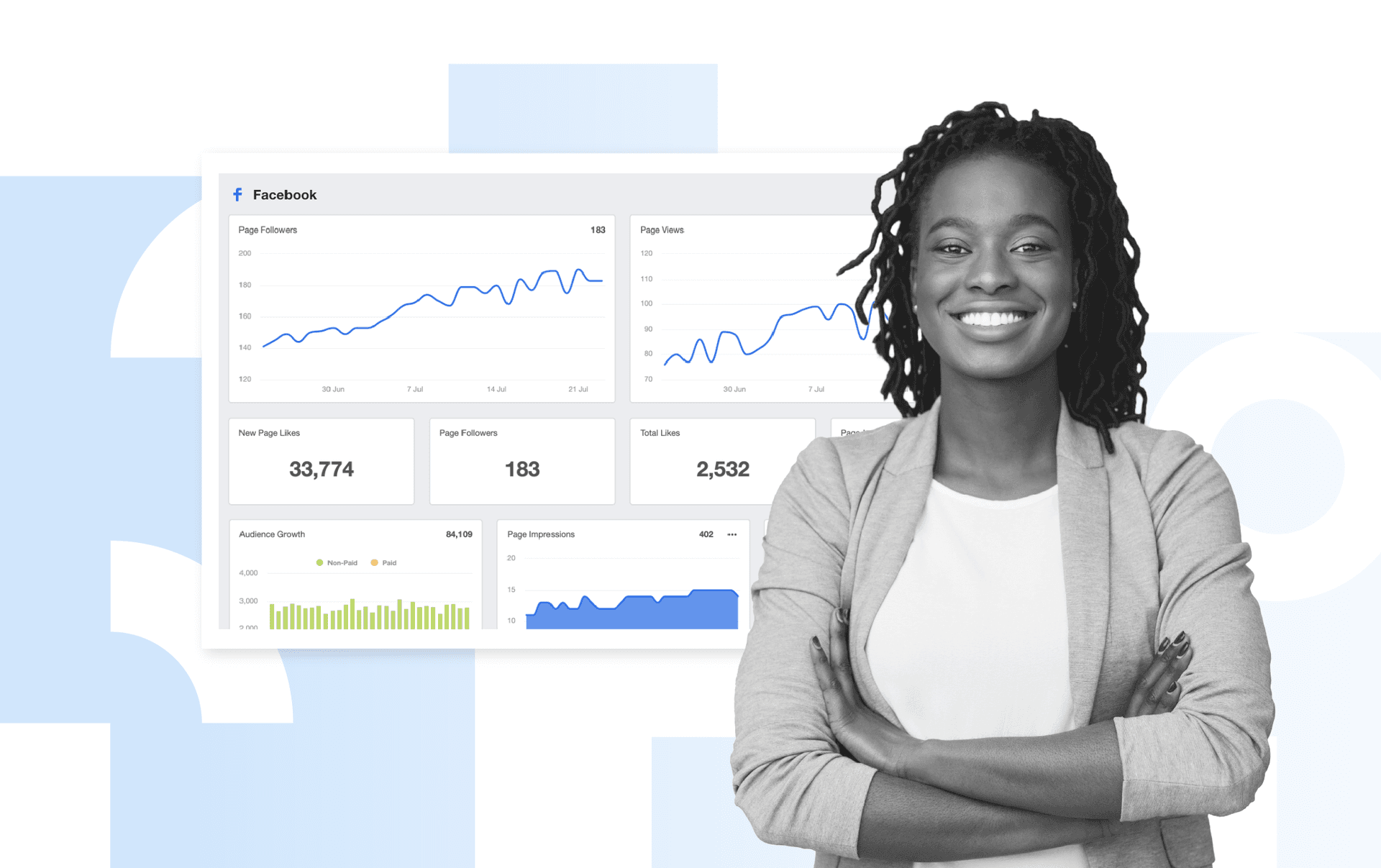Table of Contents
QUICK SUMMARY:
If you're looking to level up your social media campaigns, this article has you covered with a must-have Facebook Ads checklist for agencies. From choosing the perfect ad format and writing persuasive ad copy to ensuring compliance with Facebook’s policies, it walks you through everything you need to know. You'll also learn how to set up client accounts, optimize their websites, and boost ad performance for maximum ROI. With this checklist in hand, you’ll streamline your process and consistently deliver winning results for your clients.
Facebook, still the world’s largest social platform with 3 billion monthly active users, is inevitably going to be somewhere at the top of your client’s social media marketing plan.
There's a good reason why: It’s the most-used social platform by marketers and is consistently ranked as providing the best ROI. That said, this success raises a thorny catch-22–the more brands advertising on the platform, the tougher the competition, and the harder it becomes to achieve stellar results.
With Facebook Meta advertising, capturing audience attention requires a fine-tuned balance between choosing the right ad format and crafting persuasive ad copy. Getting these elements right makes all the difference in the effectiveness of your clients’ campaigns.
To ensure you consistently deliver results, having a Facebook Ads checklist is essential. It helps streamline the process, ensuring each campaign maximizes its potential from start to finish—boosting both performance and ROI for your clients.
Why Using a Facebook Ads Checklist is Non-Negotiable
When your team is setting up a Facebook Ad campaign for a client, there’s little room for error–mixing up terms like daily budget versus lifetime budget would quickly become a very expensive mistake.
The purpose of a Facebook Ads checklist is to make sure your team follows the right steps to set up campaigns each and every time–from start to finish. Ensuring that items on the checklist are done (and done correctly) means that come launch time, your client’s Facebook Advertising campaign sprints off the starter block without stumbling.
If you hear phrases like: “I forgot to…”, “I wasn’t sure so I just put…”, and “What’s this mean?”, you should definitely adopt a Facebook Ads checklist.
Facebook advertising is important for businesses as the Meta company (and thus Facebook or Meta Ads) enables business owners to advertise across all Meta platforms. Additionally, it's a great way to remarket to your audiences in a place that feels natural to them.
Joeri Vanhamel, Head of SEO & Marketing, Succeed Digital
Key Requirements Before Building a Facebook Advertising Campaign
A killer Facebook Ads campaign begins long before your creative team starts noodling on the strategy. Let’s take a look at some of the steps you’ll need to take before diving in.
Access Your Client’s Facebook Advertising Account
First, your agency will need admin, editor, or advertiser access to Meta Business Suite, formerly Business Manager, to set up Facebook Ad campaigns for clients. Meta Business Suite provides combined access to analytics, advertising, and content for both Facebook and Instagram pages.
Next, set up a reliable active payment method, which will be charged for active ads. Any billing problems and Facebook will pause ads.
Ensure the Client’s Website Is up to Code
You’ll need to do several checks on any client-side digital property before you start on ad work. Websites, ecommerce platforms and landing pages need to be secured with HTTPS, have accessible privacy policies, and comply with Facebook’s advertising policies and guidelines. Domain verification is required for any business directing Facebook users off the social media network to a different ecommerce platform. It proves to Meta that your client legitimately represents that account and prevents fraudulent activity.
Next, review campaign landing pages. Ensure that you have the correct landing page links from the client. Take a moment to ensure landing pages are functional and mobile-responsive. Increase Facebook Ad campaign performance by optimizing the landing page for conversions. Lastly, iron out any wrinkles in your customer journey with consistent branding and messaging across advertisement and landing page, and make sure the landing page delivers on the ad promise.
Impress clients and save hours with custom, automated reporting.
Join 7,000+ agencies that create reports in under 30 minutes per client using AgencyAnalytics. Get started for free. No credit card required.
Review and Comply With Facebook’s Advertising Policies
Take the time to familiarize yourself with Facebook’s policies on restricted content and advertising requirements. Outlined in their Community Standards, Advertising Standards, and Commerce Policies, these requirements dictate what products or services can be sold on the platform, along with permissible ad content. Failure to comply can result in severe restrictions like advertising spending limits, loss of ad features, or rejection from Meta platforms.
One requirement worth highlighting is special ad categories. To meet Facebook Advertising standards, advertisers must indicate if their campaign falls under any of the four following categories. For credit, employment or housing opportunities, you’ll notice that audience targeting options are restricted to protect people from unlawful discrimination. For example, Facebook wants to prevent employers from promoting job postings only to men, or credit lenders from preying on vulnerable lower-income individuals.
You must indicate if your client’s campaign covers:
Employment: Ads that promote employment opportunities, professional certification programs, job boards, and aggregation services.
Housing: Advertising real estate listings, homeowners insurance, mortgage loans, housing repairs and appraisal services.
Political: Ads for candidates running for public office or campaigns raising awareness about social issues like health, civil or social rights.
Financial: Beginning in October 2024, the credit ad category will be rolled into the broader category of financial products and services such as insurance, bank accounts, investment services, credit cards, loans and debt consolidation.
Ensure Proper Meta Pixel Setup
The Meta pixel logs data on conversions and measures the success of your ads by tracking what actions people take after clicking on them. It also drives sales by supporting automatic bidding to target higher-intent customers who are more likely to make a purchase and to remarket to earlier visitors. Every page on your client’s website will need a Meta pixel custom code snippet installed before this feature can be activated in the management dashboard. For reference, read this article on how to properly install it.

Track metrics on every ad platform you’re managing, across multiple accounts! Try AgencyAnalytics free for 14 days.
The Ultimate Step-by-Step Facebook Ads Checklist
Now that we’ve laid the groundwork for your client’s campaign, it’s time to hit the ground running. Elevate your Facebook Ad strategy with our step-by-step Facebook Ads checklist. From defining your campaign objectives, to optimizing your ad placements, to creating easy-to-understand client reports, these guidelines will help you achieve exceptional results.
There is no other platform that allows for creative testing at scale like Facebook. From small businesses to fortune 100 companies, every business can benefit from the ability to iterate, move quickly, and learn what’s working for your advertising efforts.
Imagine being able to launch experiments/campaigns and have your learnings within the first two weeks of being in market. You have full control of your budgets, your targeting, your copy, your creative, and your scaling capabilities. I believe Facebook should be a distribution channel for every business in one way or another. Whether you’re looking to build awareness or drive leads/sales, you can do it all.
JC Polonia, Founder, Digitality Marketing
Step 1: Choose Your Facebook Advertising Campaign Objective
When you start building a Facebook Ad campaign, you’ll immediately be prompted to choose from one of six campaign objectives. Your choice will greatly impact campaign costs because Facebook uses your objective to prioritize who to show your ads to.
Here’s a quick run-down of the six campaign objectives you can choose from:
1. Awareness: Facebook will aim to bring awareness to the targeted business or brand by reaching the largest number of people who are most likely to remember the ad.
2. Traffic: Increase traffic to a Facebook Page, website or app.
3. Engagement: Locate users most likely to take the desired actions on an ad or Page.
4. Leads: Collect leads via messages, phone calls or signups.
5. App Promotion: Get people on mobile devices to install an app, try a new feature or make an in-app purchase.
6. Sales: Discover people likely to purchase goods or services. Under normal circumstances Facebook defaults to the lower-cost option. But if you choose conversion or sales as your Facebook Ad objective, Facebook will pursue the more expensive person (i.e. the more valuable, higher intent lead) to better meet your goals because they are more likely to take the desired action.
Step 2: Set Your Facebook Ad Budget
Facebook uses an auction system to determine advertising costs. Costs are variable across industries and depend on a client’s Facebook Ad campaign goals, ad target audience, keywords and maximum bid.
That said, here are some general numbers that can provide a rough frame of reference. Facebook bills advertisers based on two metrics–cost per click (CPC) and cost per mille (CPM). A 2024 survey found that the average Facebook Ad cost $0.63 per click, while a thousand impressions ran advertisers around $9.78. When considering how much budget to allocate towards Facebook, weigh your client’s overall goals with how much of their audience is on the platform.
Step 3: Set Your Budget Duration
Once you’ve got that final budget number, you’ll have to choose from two budget durations: lifetime budget and daily budget. A lifetime budget caps how much is spent over the entire run-time of a campaign or ad-set. Overall spend will not be exceeded, but your client needs to have flexibility on daily or weekly cash flow as Facebook will spend more to take advantage of a well-performing ad day. Only lifetime budget allows you to control what time of the day your ads run.
If the budget fluctuates or your client aims for consistent daily performance targets, daily budget may be a better option. Daily spending is limited to +25% of the daily target, so advertising costs will follow a more predictable pattern and allow clients to take things day by day.
Step 4: Select Your Budget Strategy
There are two ways to allocate a Facebook advertising budget. If you want granular control, set individual targets for each ad set. Or to get the best possible results at the lowest cost, Facebook recommends deploying Meta Advantage campaign budget as the preferable budget strategy.
This strategy allows you to instead allocate a central campaign budget, with Facebook automatically managing the budget across all ad subsets–continuously awarding funds to the best-performing ads to capitalize on emerging opportunities. This minimizes money potentially wasted on underperforming ads and simplifies the number of budgets you have to manage manually.
Step 5: Find Your Target Audience
You’re looking to separate the digital wheat from the chaff; finding that sweet, sweet target audience that will interact with the ad and take the desired action. To do that, first decide if the Facebook Advertising campaign is going to be broad or deep. Facebook offers a plethora of targeting options roughly divided into demographics, interest and behaviors, with plenty of options to further narrow things down.
Facebook says their ad delivery system is at its best when working with an audience size between 2 and 10 million people, giving the auction more opportunities to successfully bid on ads and optimize performance. Use the demographics of location, age, gender and language to initially focus the audience down from, say, an entire nation-state.
With a minimum pool of 2 million potential users, start layering on interest or value-based targeting to create a custom audience that better matches your client’s customer personas.
It’s simple to start audience-building from Meta Business Suite, but additional features are available if you jump over to Ads Manager. Location-based targeting is expanded from the default “include selected location” option by using the drop-down menu to exclude locations. Unchecking the box “reach more people likely to respond to your ads” restricts ad display to people who live in the area. It’s a great option to use though if you want to include people who are interested in traveling or shopping in your targeted campaign region.
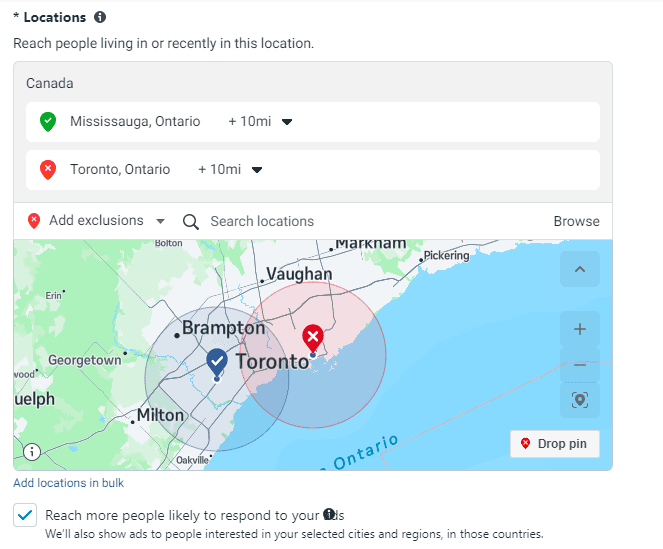
Let’s say your client is a used car reseller, who wants to unload some excess 6-passenger vehicles they’ve had sitting in the lot all winter. Under Detailed Targeting select your starting parameters. Add new targeting details to refine the audience by clicking Narrow Further. You want your second layer of criteria to say “and must also match” directly above to ensure the restrictions are layering properly.
Continue to add Narrow Further constraints until you’re happy with audience granularity. It’s worth checking out Life Events, Friends Of, and Digital Activities if you’re trying to expand beyond basic demographics into life milestones and habits.

Facebook actually offers three ways to build audiences in Ad Manager:
1. Core Audiences: This is the audience type covered in detail above. It’s Facebook’s default selection and attracts a new audience based on location, demographics and interests.
2. Custom Audiences: Specifically for retargeting, this type reconnects with users who have already engaged with content or a website, profile or app. Your client will need to have a Meta pixel already set up to use Custom Audiences. Import a contact list of over 100 leads into Facebook to reach specific individuals.
3. Lookalike Audiences: To build a lookalike audience, you load up a seed audience of a minimum of 100 existing customers (recommended amount is between 1,000 to 5,000), and Facebook identifies new people with similar characteristics who are likely to be interested in your client’s ad. This is a great way to profile your best customers. A percentage range controls how closely the lookalike audience resembles the source audience.
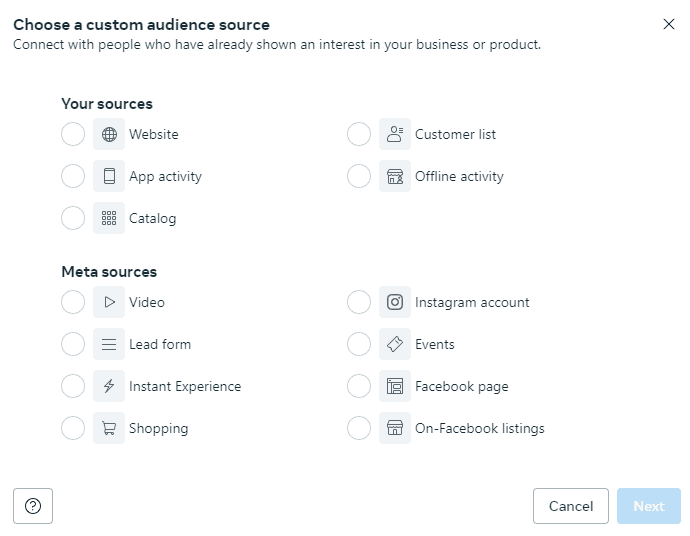
Step 6: Choose Ad Placements
Next up, you have to determine the types of ads and where in Facebook they should appear. Placements are chosen by ad set. By default, Advantage+ Placements are selected, giving Facebook the power to choose any ad placement that it thinks will garner you the most desired actions.
If you have a specific plan and want more control, manually select available ad placements by platform, device, and whether they're for mobile or desktop. To optimize campaign performance, review Facebook’s detailed checklist of ad placements by objective to make sure you've chosen the most effective Facebook Ad formats and haven't missed any opportunities.
Placements are grouped into five main categories:
Feeds
Stories
Instream ads for videos and reels
Search
Messages
Experimenting by letting Advantage+ test out different placements for a new client or a new Facebook campaign is a fast and efficient way to quickly gather optimization data. Guided by the performance goal and budget, Facebook uses historical data about ad performance and target audience behavior to constantly make adjustments to where the ad is displayed. It’s especially powerful when the goal is to drive purchases as it really hones in on the right people at the right time.
Agency Advice: A word of caution about Audience Network ads like rewarded and in-stream videos: External websites and apps that participate in Facebook's Audience Network can earn money by displaying Meta Ads. However, this may make them vulnerable to click fraud, bot activity, and inflated view counts. Advertisers could wind up paying for invalid clicks and views, negatively impacting their Facebook campaign performance and ROI.
Step 7: Create Your Facebook Ads
When making your Facebook Ad campaign, generate ad creative that can be used to A/B test across audiences and devices. From Facebook's range of call-to-action options, select the one that most effectively motivates users to take the desired action and aligns with your client’s campaign objective.
Our Facebook Ads expert, Alana Cosic, preaches to test a variety of content as audiences for different types of businesses respond differently to different types of content.
Alex Kutschukian, Red Herring Digital
Double check that you’re adhering to character limits for ad copy and design specs to avoid truncated text or low quality imagery. Optimize imagery and video for mobile devices and different Facebook Ad formats, especially if you are using Advantage+, as your ad could be adapted to any available format.
Testing is crucial. If you ever were unsure about which image size will work best for your audience, run the different-sized images, with the same ad campaign and to the same audience on a low budget for a few days. This will give you the data you need on which image size is most engaging for that audience.
Guy Hudson, Vice President of Digital Marketing at We Are Marketable
Step 8: Report on Facebook Ad Campaigns
Overwhelming clients with too much performance data can be as problematic as providing too little information. Facebook Ads Manager has over 350 different metrics and ad terms, bogging down agencies and their clients when it comes to their monitoring and optimization efforts.
Instead, distill 350 unnecessary data points into only the essentials for effective client reporting. Here are the top Facebook Ad metrics to track for client Facebook Ads:
Results: The total number of times your client’s campaign received its desired outcome.
Cost per Result: How much each desired result (or action) cost.
Conversion Rate: The percentage of desired results achieved compared to the total number of impressions.
Spend: The total amount your client’s ads cost for the selected time period.
Return on Ad Spend: The amount of revenue your client earned for every dollar invested into advertising.
Impressions: The number of times your client’s ads were on screen in front of the audience.
Cost per Mille: The cost to achieve a thousand impressions.
Frequency: The average number of times a person has seen your client’s ad.
Clicks: The total number of times people have clicked your client’s ad's link.
Click-through Rate: The number of clicks compared to the number of impressions.
Post Engagement: The total number of reactions, shares, comments, and clicks that your client’s ad received.
More than 7,000 marketing agencies are already using AgencyAnalytics’ white label reporting tools, including the Facebook Ads dashboard and the Meta report template, to monitor and report on key client KPIs, effortlessly tracking campaign performance.
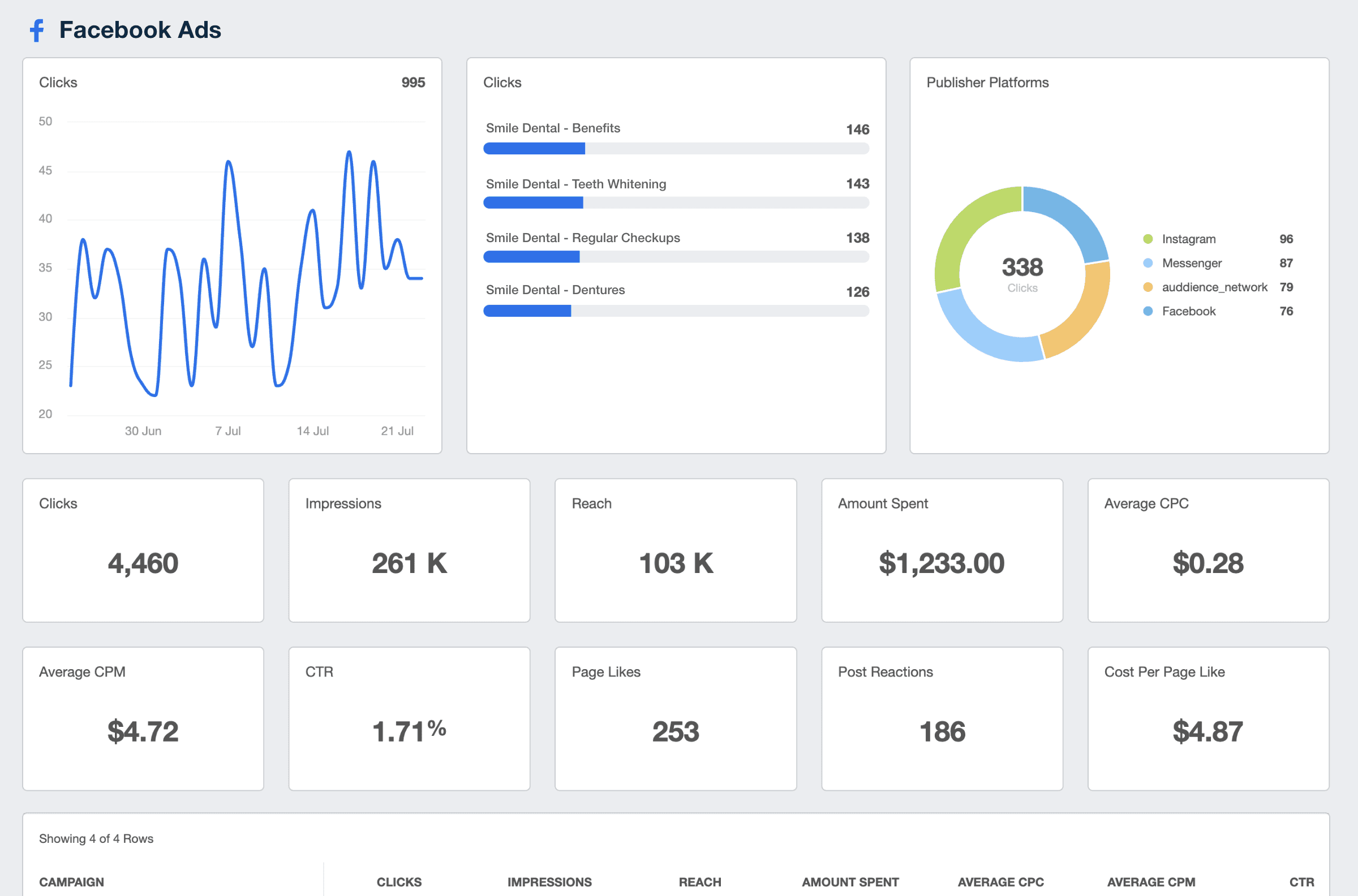
Add the metrics that matter most to your client into the live dashboard to provide actionable insights you can use to accelerate client ROI. Visualize Facebook Ad metrics in real-time, at scale across all of your clients, saving you countless billable hours.
Gone are the days of trying to access multiple ad accounts or platforms. It’s also simple to integrate metrics from 80 other platforms, allowing you easily compare Google Ads vs. Facebook Ads cost side-by-side.
Using our Facebook Ads reporting tool, agencies present customizable reports under their own brand, enhancing professionalism and trust. Jump in utilizing our free, pre-made Facebook Ads report template to get you started in record time. Automatically pull metrics like impressions, clicks, conversions, and cost at a granular level, creating Facebook reports worthy of your agency’s high standards.

Low on time? Pull in-depth insights from your client’s Facebook Ads campaigns by using Ask AI and AI Summaries from AgencyAnalytics! Sign up for a free 14-day trial today.
Conclusion
By utilizing a Facebook Ads optimization checklist, your agency will significantly enhance the effectiveness of your campaigns, ensuring they meet client objectives and deliver exceptional results.
Tired of fighting with Facebook's dry, clunky reporting interface? Our powerful platform helps you create clear, actionable reports that clients love. Easily automate your first Facebook dashboard or report by signing up for a free 14-day trial with AgencyAnalytics.

Written by
Lia Van Baalen is a Canadian content marketer with a decade of experience writing B2B content for SaaS, manufacturing and renewable energy companies. In her opinion, nothing is quite so satisfying in marketing as a good subject matter interview.
Read more posts by Lia Van BaalenSee how 7,000+ marketing agencies help clients win
Free 14-day trial. No credit card required.



